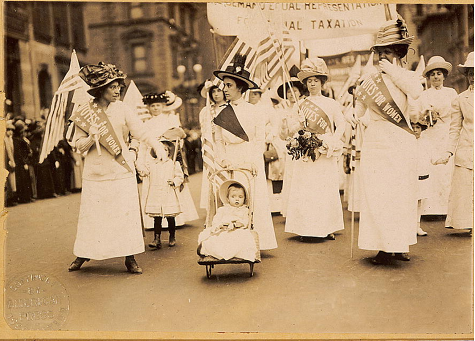42c. Women's Suffrage at Last

Youngest parader in New York City suffragist parade
American Press AssociationSuffrage parade, New York City, May 4, 1912
Preserved by the Library of Congress
After the Seneca Falls Convention of 1848 demanded women's suffrage for the first time, America became distracted by the coming Civil War. The issue of the vote resurfaced during Reconstruction.
The Fifteenth Amendment to the Constitution proposed granting the right to vote to African American males. Many female suffragists at the time were outraged. They simply could not believe that those who suffered 350 years of bondage would be enfranchised before America's women.
A Movement Divided
Activists such as Frederick Douglass, Lucy Stone, and Henry Blackwell argued that the 1860s was the time for the black male. Linking black suffrage with female suffrage would surely accomplish neither. Susan B. Anthony, Elizabeth Cady Stanton, and Sojourner Truth disagreed. They would accept nothing less than immediate federal action supporting the vote for women.

Voting rights were guaranteed for women in the U.S. in 1920 with the passing of the Nineteenth Amendment. But women's suffrage campaigns have been fought around the world. What nations were ahead of the U.S. in voting equality and what nations still ban women from casting their votes?
Stone and Blackwell formed the American Woman Suffrage Association and believed that pressuring state governments was the most effective route. Anthony and Stanton formed the National Woman Suffrage Association and pressed for a constitutional amendment. This split occurred in 1869 and weakened the suffrage movement for the next two decades.
Anthony and Stanton engaged in high-profile, headline-grabbing tactics. In 1872, they endorsed Victoria Woodhull, the Free Love candidate, for President. The NWSA was known to show up to the polls on election day to force officials to turn them away. They set up mock ballot boxes near the election sites so women could "vote" in protest. They continued to accept no compromise on a national amendment eliminating the gender requirement.
The AWSA chose a much more understated path. Stone and Blackwell actively lobbied state governments. Wyoming became the first state to grant full women's suffrage in 1869, and Utah followed suit the following year. But then it stopped. No other states granted full suffrage until the 1890s.
|
That man over there says that women need to be helped into carriages, and lifted over ditches, and to have the best place everywhere. Nobody ever helps me into carriages, or over mud-puddles, or gives me any best place! And ain't I a woman? Look at me! Look at my arm! I have ploughed and planted, and gathered into barns, and no man could head me! And ain't I a woman? I could work as much and eat as much as a man — when I could get it — and bear the lash as well! And ain't I a woman? I have borne thirteen children, and seen most all sold off to slavery, and when I cried out with my mother's grief, none but Jesus heard me! And ain't I a woman? – Sojourner Truth. "Ain't I A Woman?" Delivered at Akron Ohio Women's Covention (1851) | ||
The NAWSA to the Rescue

Alice Stone Blackwall
After Lucy Stone and Henry Blackwell passed away, their daughter, Alice Stone Blackwell saw the need for a unified front. She approached the aging leadership of the NWSA, and in 1890, the two splinter groups formed the National American Woman Suffrage Association (NAWSA), with Elizabeth Cady Stanton and Susan B. Anthony taking turns at the presidency.
Although the movement still had internal divisions, the mood of progressive reform breathed new life into its rank and file. Although Stanton and Anthony died before ever having accomplished their goal, the stage was set for a new generation to carry the torch.
The fight to victory was conducted by Carrie Chapman Catt. By 1910, most states west of Mississippi had granted full suffrage rights to women. States of the Midwest at least permitted women to vote in Presidential elections. But the Northeast and the South were steadfast in opposition. Catt knew that to ratify a national amendment, NAWSA would have to win a state in each of these key regions. Once cracks were made, the dam would surely burst.
Amid the backdrop of the United States entry into World War I, success finally came. In 1917, New York and Arkansas permitted women to vote, and momentum shifted toward suffrage. NAWSA supported the war effort throughout the ratification process, and the prominent positions women held no doubt resulted in increased support.
On August 18, 1920, the state legislature of Tennessee ratified the Nineteenth Amendment, giving it the necessary approval in 3/4 of the states, making it the supreme law of the land. The long struggle for voting rights was over.






